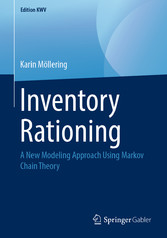Suchen und Finden
Service

Inventory Rationing - A New Modeling Approach Using Markov Chain Theory
Karin Möllering
Verlag Springer Gabler, 2019
ISBN 9783658242558 , 188 Seiten
Format PDF, OL
Kopierschutz Wasserzeichen
Geräte
Contents
8
List of Tables
14
List of Figures
16
List of Abbreviations
18
List of Symbols
20
1 Introduction
23
1.1 Motivation
24
1.2 Research Objectives
25
1.3 Outline
26
Part I Foundations of Stochastic Inventory Control
29
2 Basic Concepts of Inventory Management
30
2.1 Inventory Management and Control
31
2.2 Motivations for Holding Inventory
32
2.3 Classification of Inventories
34
2.3.1 The Strategic Perspective
34
2.3.2 The Operational Perspective
35
2.4 Inventory-related Costs
37
2.4.1 Order Cost
37
2.4.2 Holding Cost
38
2.4.3 Penalty Cost
39
2.5 Service Level
40
3 Stochastic Inventory Control
42
3.1 Characteristics of Inventory Models
43
3.1.1 Management Decisions
43
3.1.2 System-Inherent Characteristics
44
3.2 Types of Inventory Control Policies
46
3.3 Periodic Inventory Control
48
3.3.1 Single-Period Inventory Control
49
3.3.2 Multi-Period Inventory Control
50
3.3.3 Service-Constraint Multi-Period Inventory Control
53
Part II Essential Stochastic Processes
54
4 Markov Chains
55
4.1 The Markov Property
56
4.2 Homogeneous Markov Chains
57
4.3 Limit Distribution and Invariant Distribution
58
4.4 Communication Classes
60
4.5 Class Properties
61
4.5.1 Aperiodicity
61
4.5.2 Recurrency and Transiency
61
4.5.3 Class Criteria
63
4.6 Uniqueness of Limit Distributions
64
4.7 Multi-Dimensional Markov Chains
65
4.8 Applications of Markov Chains
66
5 Numerical Solution of Infinite Markov Chains
67
5.1 System Reduction Approaches
68
5.1.1 Reduced System Approaches
68
5.1.2 Geometric Tail Distributions
69
5.2 State Space Reduction Approaches
70
5.2.1 Augmentations
70
5.2.2 Pointwise Convergence
72
5.3 Algorithms
74
5.3.1 Sheskin’s Partitioning Algorithm
74
5.3.2 Power Iteration
76
5.4 Criteria for Choosing a Specific Algorithm
76
6 Comparing Stochastic Processes
78
6.1 Stochastic Ordering for Distribution Functions
78
6.2 The Sample Path Method
80
Part III Stochastic Inventory Control with Customer Segmentation
82
7 Introduction to Inventory Rationing
83
7.1 Examples for Different Customer Classes
84
7.2 Related Areas
85
7.3 Rationing Rules
87
7.4 Backorders and Backorder Clearing Mechanisms
89
7.5 Literature Review
91
7.5.1 Characterizations of the Optimal Policy
91
7.5.2 Evaluations and Optimizations of Critical Level Policies
94
7.5.3 Other Studies Involving Critical Level Rationing
98
7.6 Classification of Our Work
99
8 A Markov-Chain Based Modeling Approach
101
8.1 Modeling Framework
102
8.2 Recursive Expressions for Backorders
102
8.3 Markov Chain
104
8.4 Structural Results
105
8.5 Proofs
108
9 Prioritization by Penalty Costs
115
9.1 Optimization Approach
116
9.1.1 Convexity of Objective Function
116
9.1.2 Transition Matrix
118
9.1.3 Cost Function
119
9.1.4 Numerical Optimization Algorithm
120
9.2 Numerical Results
120
9.2.1 Critical Level Policy versus Benchmark Policies
121
9.2.2 Combination Heuristic
124
9.3 Conclusion
124
9.4 Proofs
126
10 Prioritization by Service Levels
129
10.1 Analytical Insights
130
10.1.1 Service Level Constraints
130
10.1.2 Potentially Optimal Parameter Constellations
133
10.1.3 Structural Results for the Optimal Solution
135
10.1.4 Cost Function
137
10.1.5 Model Alteration: ?-Service Levels
138
10.2 Numerical Results
139
10.2.1 Optimization Algorithm
140
10.2.2 Critical Level Policy versus Benchmark Policies
141
10.2.3 Heuristic Approach
144
10.3 Conclusion
145
10.4 Proofs
147
11 Dynamic Rationing Policies
153
11.1 The Next Period Optimization Policy
154
11.1.1 The Policy
154
11.1.2 Structural results
155
11.2 The Linear Critical Level Policy
156
11.2.1 The Policy
156
11.2.2 Structural results
157
11.3 Efficiency of the Dynamic Rationing Policies
160
11.3.1 Next Period Optimization and Constant Rationing Policy
161
11.3.2 Linear Critical Level Policy and Constant Rationing Policy
165
11.3.3 Next Period Optimization and Linear Critical Level Policy
168
11.4 Conclusion
170
11.5 Proofs
171
12 Conclusion and Critical Review
174
12.1 Contributions
174
12.2 Critical Review
176
12.3 Future Research
177
Bibliography
179
Shop


